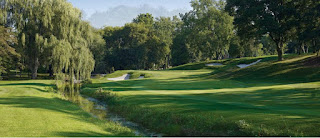
(ABOVE: approach to #14, 480 yard par 4)
"Why the hell have they been hiding this place?" - CBS Commentator David Feherty during final round coverage of the 2010 RBC Canadian Open. Said in reference to the last Canadian Open being held at St. George's in 1968.
"Some of the finest parkland terrain I have seen." - Tom Doak
St. George's Golf & Country Club is a classic parkland layout located in Etobicoke, Ontario, just minutes west of downtown Toronto. It is a Stanley Thompson design, one of the most celebrated golf course architects in Canada. (For full disclosure, I am a longtime member of St Georges, having grown up playing this course. And yes, "spoiled" would be an accurate adjective for my golf course upbringing)
In 2009, St. George's ranked #89 on Golf Magazine's Top 100 Courses in the World. While it is always an honour to be a part of the Top 100, in in my opinion, it deserves a much better ranking. It is classic, parkland style golf with great variety, flow and feel. The course is built on a fantastic piece of land, extremely rolling and undulating, making for a great walk in the park. It's undulations make for endless variety of lies - in my opinion an important characteristic of any course. The best courses in the world, e.g. Old Course, Augusta, etc, have extremely undulating fairways. This results in a shotmaker's delight - variety and challenge at every approach.
St. George's is a fine test not just for professionals, but all levels of play. It is a great "members" golf course. Wide but undulating fairways, strategic bunkering, a variety of tees and large, sloping greens. Some of the green complexes have gotten a bit extreme in recent years, for example the front of #15 green was rebuilt to avoid balls rolling 100 yards down the hill off the front. The stewards of the course are making sure the greens remain a fair and allow for a variety of pin positions, the way Thompson intended.
St. George's has one of the best "flows" to any course. The first is a warm up hole of 370 yards, but not a easy green so you had better pay attention. The first 11 holes are a great mix of tough holes and birdie holes, allowing you to get a feel for the course and your round. The member's have a saying - "the course starts at the halfway house." The funny part about that saying is that the halfway house is by the 12th tee. More like a "2/3rd's house," but anyway...
#12-#14 are played in a "loop" and are the start of what is one of the best finishes in golf. #14 is the signature par 4, Jack Nicklaus' favourite hole in Canada and the Kodak Challenge hole for the Canadian Open. It is a slightly downhill 480 yard par 4 with the approach across a small creek to a very "12 at Augusta" style green. #15 is a 570 yard par 5, #16 an uphill 214 yard par 3, #17 a 485 yard par 4, and #18 rivals #14 as the best on the course. With the classic Tudor style clubhouse behind the green, it is a great setting for the finishing hole. It plays 467 yards from the championship tees, and plays deceptively uphill to one of the best green complexes on the course. #18 is a great crescendo to a wonderful course.
The 2010 Canadian Open was the first time St. George's had hosted our National open since 1968 when Bob Charles took home the title. In preparation for 2010, under the consultation of the RCGA/Golf Canada, the PGA Tour, and Doug Carrick as an advisor, St. George's underwent some minor tree removal, back tee overhaul, and general "clean up." As it was happening, the membership was understandably a little apprehensive (myself included), but it has done wonders for the course. Tree and scrub bush removal has provided plenty of sun and air flow to greens that were previously suffocated and waterlogged. It's remarkable what sun and wind can do to improve turf quality. Furthermore, the championship tees now look like they belong - whereas before they looked like I had gone out there one night with a weed eater and a set of black markers. Overall, the return of the Canadian Open to St. George's was well received by all. The players, sponsors, fans and members at large were happy with the tournament and I would expect it to return in the next 5-7 years. In my opinion, it was unfortunate the course got so much rain that week, as it is a much better test when it's firm and breezy. Hopefully next time.
St. George's is a big, strong, championship golf course worthy of many more Canadian Opens and who knows, maybe even a future President's Cup.
Hit 'em well.
- MG
(BELOW: Approach to #18, 467 yard par 4)

